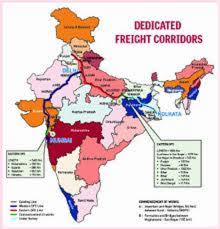 Track2Realty Exclusive: Prophets of doomsday in Mumbai who till only recently have written off the growth of the city and its realty market due to saturation and infrastructural bottlenecks are today very apprehensive lot. The proposed industrial corridors promise to open the floodgates of new investment opportunities and make them eat their own words. Mumbai which has been facing stiff competition with certain other emerging markets is expected to redefine the financial capital of the country once the first corridor Delhi-Mumbai Industrial Corridor (DMIC) project is over and investors find avenues like gold mine on the ground.
Track2Realty Exclusive: Prophets of doomsday in Mumbai who till only recently have written off the growth of the city and its realty market due to saturation and infrastructural bottlenecks are today very apprehensive lot. The proposed industrial corridors promise to open the floodgates of new investment opportunities and make them eat their own words. Mumbai which has been facing stiff competition with certain other emerging markets is expected to redefine the financial capital of the country once the first corridor Delhi-Mumbai Industrial Corridor (DMIC) project is over and investors find avenues like gold mine on the ground.
Referred as the most over ambitious infrastructure project in India and declared as one of 100 innovative global projects by consultancy firm KPMG, DMIC, a joint venture with Japan, the USD 90 billion infra project covering an overall length of 1483 KMs between the political capital and the business capital of India, i.e. Delhi and Mumbai, is poised to redefine the urban centres in the six States that it passes through— U.P, NCR of Delhi, Haryana, Rajasthan, Gujarat and Maharashtra.
There is no denying this high-speed connectivity between Delhi and Mumbai offers immense opportunities for development of an industrial corridor along the alignment of the connecting infrastructure. Urban planning experts are wondering whether the efforts to build a strong manufacturing base, quite like what Japan did after World War II, is destined to change the way Indian metro cities in general and Mumbai in particular are being seen—decaying.
Amitabh Kant, CEO and MD of Delhi Mumbai Industrial Corridor Development Corporation (DMICDC) seems to be bullish when he says that the manufacturing hubs that the DMIC is creating will be critical to future growth. It is among the key components of the National Manufacturing Policy (NMP) that aims to raise the share of the manufacturing from 16 per cent of GDP to 25 per cent within a decade. The NMP would be a key enabler for DMIC. It is expected to create 10 crore new jobs by 2022.
Not only this, the icing on the cake of Mumbai market is the fact that buoyed by rapid progress of the Delhi Mumbai Industrial Corridor project, Finance Minister P Chidambaram has announced in the 2013-14 budget two more industrial corridors between Bangalore and Chennai and Bangalore and Mumbai. Union Commerce Minister Anand Sharma later confirms that the government has agreed, in principle, for a feasibility study of the proposed Mumbai-Bangalore industrial corridor and the government is working on terms of reference of the proposed corridor.
Mumbai property watchers believe industrial corridors will definitely help develop new industrial cities as ‘Smart Cities’ and also provide a boost to the infrastructure sector. Such projects will help in expanding Mumbai’s manufacturing and services base. Industrial corridors have the potential to provide a major impetus to planned urbanisation. Such corridors will help develop infrastructure linkages such as pioneer plants, assured water supply, high capacity transportation and logistics facilities. Also, industrial corridors will provide employment to the local population. Besides reviving the real estate sector in Mumbai, industrial corridors will also provide a boost to the city’s economy.
Lalit Jain, CREDAI Chairman and CMD of Kumar Urban Development agrees that industrial corridors will change the landscape of the towns and cities that lie along their alignment. For instance, DMIC will help build smart cities that are at par with international cities. It will develop infrastructure in at least seven cities spread across six states. Development of such a corridor will require townships and commercial establishments to be built along the corridor. Thus, there will be an increased trading activity between these cities, and this will help generate demand for commercial and residential real estate projects in the corridor. So, the real estate sector in general stands to benefit significantly with the development of industrial corridors.
“Being the financial capital of the country, Mumbai will always have that ‘extra edge’ as compared to other cities lying on this corridor. Development of infrastructure on this route will help provide a boost to the city’s economy. Trade and commerce in the city will increase with the development of the corridor. Also, the city will attract foreign investments and attain sustainable development. So, the DMIC will only help Mumbai consolidate its position as the numero uno city and real estate stands to gain,” says Jain.
Gaurav Gupta, Director Omkar Realtors & Developers maintains Mumbai is truly an international city and a hub of social and economic development. The DMIC and the BMIC (Bangalore-Mumbai Industrial Corridor) will surely increase connectivity in a substantial way. The real estate market on the whole will increase manifold and Mumbai would possibly reap the benefits of this extended real estate and infrastructure boom.
“An iconic international city like Mumbai which was once at the peak of industrialization, is dynamically evolving with expansion and infrastructure development. The industrial corridors which are a being planned across the length of the country can be seen as another way of allowing investment flow to the concerned cities and towns in the path. The development of these cities will tend to have a spiral effect on the real estate market as well which would definitely add to the natural growth of the city. The key, however, lies in expediting the execution of infrastructure projects and we hope that the Cabinet Committee on Investment (CCI) would help achieve this objective,” says Gupta.
Not that the Maharashtra Government is not aware of the lost ground and the opportunities that has been thrown open with the proposed industrial corridors. And hence it has taken many steps as per Package Scheme of Incentives and it falls under D+ industrial zone, an impetus to the IT industry. It has also setup several state-of-the-art IT parks within the state, Special Economic Zones, Specialized Industrial Parks, Floriculture Park – Pune, Specialized Food Parks, Specialized Food Parks, Specialized Food Parks and many such incentives have been taken. However GOM has been little slow than other states resulting in other states developing faster.
Diipesh Bhagtani, Executive Director, Jaycee Homes believes it will not only provide a boost to commercial real estate in Mumbai, but it will also spur other areas of real estate like residential, retail and hospitality. Any infrastructural development activity always has a ripple effect that is reflected in demand for property. According to him, with this corridor connecting Mumbai with Delhi, one can expect a healthy growth in the real estate sector in particular and economy of Mumbai in general.
“The movement of goods and people between cities will enhance trade and commerce. It will also reduce the time taken to ply goods between two cities. Industrial corridors also enhance business opportunities for the people of the states. There will be decongestion in all the states. This increased activity will spur development along the corridor, resulting in demand for property for residential, commercial, retail and hospitality sectors. This corridor will help small and medium scale industries to develop, thus boosting demand for residential and commercial space,” says Bhagtani.
This high-speed connectivity between Delhi and Mumbai or Mumbai and Bangalore offers immense opportunities for development of an industrial corridor along the alignment of the connecting infrastructure. The vision is to create strong economic base in this band with globally competitive environment and state-of-the-art infrastructure to activate local commerce, enhance foreign investments, real-estate investments and attain sustainable development. In addition to the influence region, these corridors would also include development of requisite feeder rail/road connectivity to hinterland/markets and select ports along the western coast. And for the critics of Mumbai’s growth, it is time for a break.
Delhi-Mumbai Industrial Corridor (DMIC) and other proposed corridors promise to change the Indian urban landscape opening floodgates of economic opportunities when it is completed. That “when”, however, is a big question mark. It is not just about the timing, but it is also a case of mindset where states need to get their act together as some basic issues are yet to be ironed out. While the over ambitious and innovative DMIC faces execution bottlenecks, one keeps the fingers crossed that it is not destined to meet the fate of the SEZs in India.
DMIC Stats
Investment—USD 90 billion
Length—1483 KMs between Delhi and Mumbai
Covered States—U.P, NCR of Delhi, Haryana, Rajasthan, Gujarat and Maharashtra
End to End Terminals—Dadri in the National Capital Region of Delhi and Jawaharlal Nehru Port near Mumbai
Infrastructure Creation—Nine Mega Industrial zones of about 200-250 sq. km., high speed freight line, three ports, and six air ports; a six-lane intersection-free expressway connecting Delhi and Mumbai and a 4000 MW power plant
Jobs Creation—10 crore by 2022





